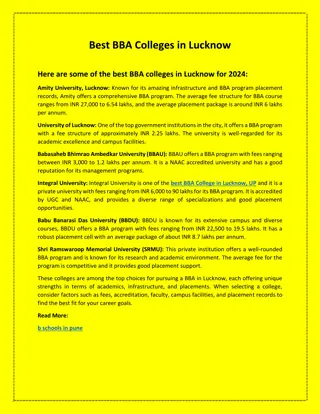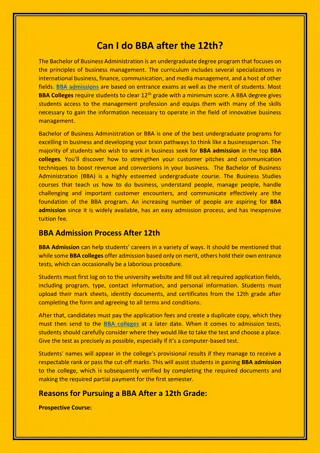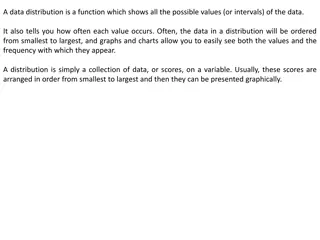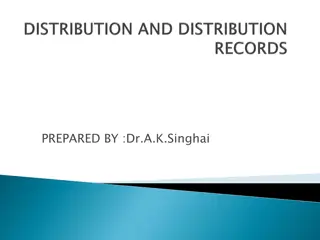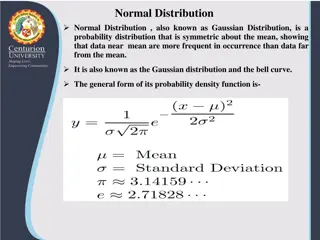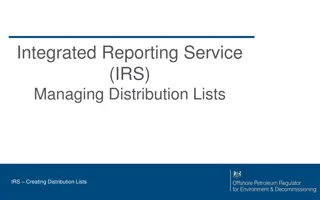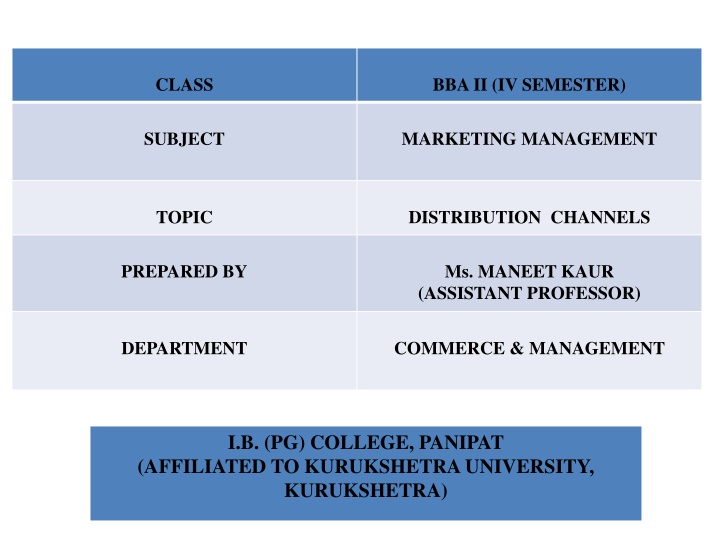
Key Aspects of Distribution Channels in Marketing Management
Learn about the significance, definition, characteristics, and roles of distribution channels in marketing management. Explore how these channels facilitate the flow of goods, influence consumer decisions, reduce costs, and enhance overall business performance.
Download Presentation

Please find below an Image/Link to download the presentation.
The content on the website is provided AS IS for your information and personal use only. It may not be sold, licensed, or shared on other websites without obtaining consent from the author. If you encounter any issues during the download, it is possible that the publisher has removed the file from their server.
You are allowed to download the files provided on this website for personal or commercial use, subject to the condition that they are used lawfully. All files are the property of their respective owners.
The content on the website is provided AS IS for your information and personal use only. It may not be sold, licensed, or shared on other websites without obtaining consent from the author.
E N D
Presentation Transcript
CLASS BBA II (IV SEMESTER) SUBJECT MARKETING MANAGEMENT TOPIC DISTRIBUTION CHANNELS PREPARED BY Ms. MANEET KAUR (ASSISTANT PROFESSOR) DEPARTMENT COMMERCE & MANAGEMENT I.B. (PG) COLLEGE, PANIPAT (AFFILIATED TO KURUKSHETRA UNIVERSITY, KURUKSHETRA)
INTRODUCTION Distribution Channels are those channels which are used by various organizations for the flow of products from the point of production to the consumption. The channels of distribution are also known as Trade Channels point of ultimate PRODUCER INTERMEDIARIES CONSUMERS
DISTRIBUTION CHANNELS DEFINITION: Every producer seeks to link together the set of marketing intermediaries that best fulfill the firm s objectives. The set of marketing intermediaries is called the marketing channel or trade channel or distribution channel. - Philip Kotler Channel of distribution is the structure of intra company organization units and extra company agents and dealers, wholesale and retail, through which a commodity, a product or service is marketed. -American Marketing Association
CHARACTERISTICS OF DISTRIBUTION CHANNEL Route or Pathway Flow of Goods Functions Merchantile Agents Composition Remuneration
ROLE OF DISTRIBUTION CHANNELS Distribution transaction by making the route of purchasing decision. Distribution channel act as communication agent often guided the consumers in the right direction to fulfill their wants. Persuading and influencing the prospective buyers to favor a certain product and its manufacturer. Participating actively in the creation and establishment of market for a new product . channels reduces the cost of any
CONTINUED Looking after all physical distribution functions. Transferring of new technology to the users along with the supply of products and playing the role of change agents. Offering pre-sale and after sale services to consumers Providing feedback information , marketing intelligence and sale forecasting services for their regions to their manufacturers.
FUNCTIONS OF DITRIBUTION CHANNELS Contact between Producer and Consumers. Transferring the title. Satisfaction to the consumers. Performing promotional activities. Creating time and place utilities. Fixing prices. Function of communication information. Help in production function.
TYPES OF DISTRIBUTION CHANNELS 1. CONVENTIONAL DISTRIBUTION CHANNELS DIRECT INDIRECT (i) One level. (ii) Two level. (iii) Multi-level
TYPES OF DISTRIBUTION CHANNELS 2. NON-CONVENTIONAL DISTRIBUTION CHANNELS VERTICAL HORIZONTAL (i) Corporate. (ii) Administrated. (iii) Contractual.
CONVENTIONAL DISTRIBUTION CHANNELS These are the traditional channels in which the participants operate on the basis of self interest, concerned only with the organization from where they buy and to whom they sell. In conventional distribution channels, there are four channel designs such as: Direct : (i) Zero level. Indirect: (ii) One level. (iii) Two level. (iv) Multi-level.
CONVENTIONAL CHANNELS FOR CONSUMER PRODUCTS Conventional channels are the fragmented networks in which consumers are loosely linked by middlemen in the process of exchange. Conventional channels are of two types: Direct Distribution Channel Indirect Distribution Channel. producers and the
DIRECT DISTRIBUTION CHANNEL In this channel, the producer directly sells his products to the ultimate involvement of any middlemen. That is why, it is called direct channel and zero-level distribution channel. It can be illustrated as:- consumers without MANUFACTURER ULTIMATE CONSUMER
ADVANTAGES OF DIRECT DISTRIBUTION CHANNEL Consumers get the products in their pure form. It is economical method of selling. The price of products remain low because of less cost. Manufacturers directly estimate the demand of the consumers. Close contact between producer and consumers.
DISADVANTAGES OF DIRECT DISTRIBUTION CHANNEL The sales level remain low. It is not suitable in case of mass production and sales at large scale. All risks and losses lies with the manufacturers. It is not suitable when consumers are widely scattered. Consumers has to pay a price which is fixed by the manufacturer.
INDIRECT DISTRIBUTION CHANNELS Indirect distribution channels are those channels in which manufacturer sells his products with the help of the middlemen in process of exchange. The whole process of indirect distribution channel looks like a chain. ONE LEVEL MANUFACTURER RETAILER CONSUMER TWO LEVEL MANUFACTURER WHOLESALER RETAILER CONSUMER MULTI LEVEL: MANUFACTURER SELLINGAGENTS WHOLESALERS RETAILERS CONSUMERS
ONE LEVEL CHANNEL OF DISTRIBUTION Under this system, manufacturer sell their product to retailers and retailers sell them in turn to ultimate consumers. In this, manufacturer allows the retailers or wholesalers to have direct access to him. It can be illustrated as under: MANUFACTURER RETAILERS CONSUMER MANUFACTURER WHOLESALERS CONSUMER
TWO LEVEL CHANNEL OF DISTRIBUTION This is traditional channel of distribution in which producer sell his products with the help of two middlemen for sale of consumer products. There are two types of middlemen i.e., wholesalers and retailers. The wholesalers distribute the products to retailers as per their requirements and in turn retailers finally sells the same to the ultimate consumers. It can be illustrated as under: MANUFACTURER WHOLESALERS RETAILERS CONSUMER
MULTI-LEVEL CHANNEL OF DISTRIBUTION This is the longest channel of distribution. A company with diversified product may find it more appropriate to distribution channels. This channel is used where the wholesalers are scattered throughout the country and selling agents undertake marketing on the behalf of the manufacturers. It can be illustrated as under: adopt a variety of MANUFACTURER SELLING AGENTS WHOLESALERS RETAILERS CONSUMERS
VERTICAL DISTRIBUTION CHANNEL SYSTEM A vertical marketing system is the result of failure of conventional channels where each channel participant works with independent separate identity, seeking to achieve its own objectives. Vertical distribution channels are professionally managed and centrally programmed networks, pre-engineered to achieve operating economies and maximum market impact. There are three types of vertically integrated marketing channels: i. Corporate System. ii. Administrated Vertical System. iii. Contractual Marketing System.
NON-CONVENTIONAL CHANNELS OF DISTRIBUTION These are the networks in which channel components participate in a full co-ordination and cohesion manner rather than working in a loose manner. This is also known as integrated channels of distribution. The non-conventional channel are of two types: I. Vertical Distribution Channel System. II. Horizontal Distribution Channel System.
TYPES OF VERTICALLY INTEGRATED DISTRIBUTION CHANNELS CORPORATE SYSTEM/CHANNEL: In corporate vertical distribution system, a single firm owns both production and distribution facilities like Bata, Tata, Modi, Godrej, etc. with their own production units and retail outlets are the best examples of this system. ADMINISTRATED VERTICAL SYSTEM/CHANNEL: In this, there is full coordination in all the functions of production and distribution by using well developed programme in one or more number of limited firms throughout the whole marketing system. CONTRACTUAL MARKETING SYSTEM/CHANNEL: Under this system, independent channel components manufacturer, wholesalers and retailers are employed on a voluntary basis to develop a more efficient system on a contractual basis, so as to obtain economies of scale and increase market impact.
HORIZONTAL DISTRIBUTION CHANNEL/SYSTEM It is a new trend in distribution channel in which one or more companies join hands to exploits a marketing opportunity either by themselves or by creating an independent unit. The reasons for horizontal integration are the ever changing markets, cut throat competition, changing pace of technology, excess capacity, cyclical and seasonal changes in consumer demand and the incapacity to take financial risks single handed and so on. Some examples of this kind of system are Maruti Udyog and HDFC Bank, Associated Cement Company, etc.
Factors Affecting Channel Choice MIDDLEMEN Considerations COMPANY Considerations Financial strength Size of the Company Past channel experience Reputation of the company Product Mix Marketing experience Availability of middlemen Attitude of middlemen Services provided by middlemen Cost of Channel Sales volume potentials Financial ability
THANK YOU & STAY SAFE




